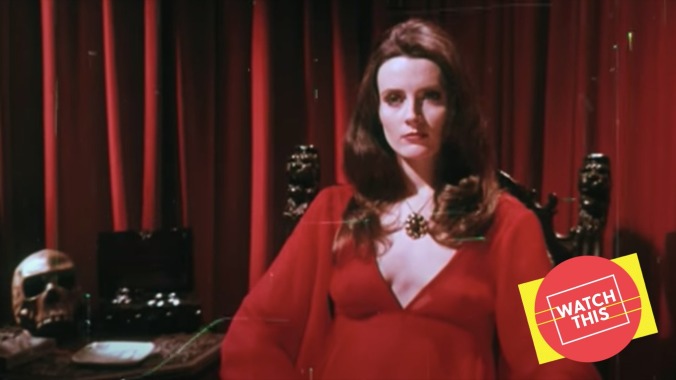Dreamy and atmospheric, The Velvet Vampire added a subversive edge to its sexy slow burn

Watch This offers movie recommendations inspired by new releases, premieres, current events, or occasionally just our own inscrutable whims. This week: Morbius has been pushed back to 2021, but you don’t have to wait that long to check out these other vampire chronicles and bloodsucker tales.
The Velvet Vampire (1971)
The desert seems like an odd place for a vampire, doesn’t it? It’s hot and dry, the opposite of the clammy tombs where the undead generally prefer to lurk. Prey, both animal and human, is scarce. And it’s all because of the sun, a vampire’s greatest nemesis, which beats down with an intensity that can can be fatal even to mortals. But the desert is also the perfect hiding place for those who—whether their motivations be innocent or sinister—don’t want too many eyes on them as they go about their business. So the arid landscape of inland California serves as a sanctuary for Diane LeFanu (Celeste Yarnall), the art collector, dune-buggy enthusiast, and immortal bloodsucker whose seductive tactics (and plush wardrobe) give Stephanie Rothman’s The Velvet Vampire its name.
The first woman to receive a Director’s Guild Of America fellowship, Rothman was one of the many promising young filmmakers snapped up by B-movie king Roger Corman in the late ’60s to make movies for his latest venture, New World Pictures. Unlike her contemporaries Jonathan Demme and Francis Ford Coppola, however, Rothman was never able to transcend the “exploitation” label, and left filmmaking altogether in the mid-’70s. Before that departure, she directed seven films that smuggled relevant social issues into pulpy fare with provocative titles like The Student Nurses (1970) and Group Marriage (1973). As she put it in a 2016 interview:
I was making low-budget films that were transgressive in that they showed more extreme things than what would be shown in a studio film, and whose success depended on their advertising, because they had no stars in them. It was dismaying to me, but at the same time I decided to make the best exploitation films I could.
When The Velvet Vampire hit drive-ins in August 1971, Charles Manson still ruled the California desert in America’s pop-culture consciousness. Co-writer and director Rothman harnesses the anxieties of the era for a cautionary tale about the dangers of free love and hippie naiveté. The plot revolves around a hip young married couple, Lee (Michael Blodgett) and Susan (Sherry Miles), who find themselves inexplicably drawn to the gorgeous, sophisticated Diane after meeting her at an after-hours art exhibit in Los Angeles. At first, Susan is understandably suspicious of this mysterious newcomer who keeps running her hands through her husband’s chest hair. Lee, meanwhile, is instantly spellbound, and accepts Diane’s invitation to spend the weekend at her desert hacienda before Susan can say no.
Once Lee and Susan arrive at Diane’s sprawling Spanish-style ranch house out in the middle of nowhere, The Velvet Vampire begins its plunge into dreamy Technicolor surrealism, cut with both perverse danger and profound loneliness. Lee and Susan begin having the same dream every night, of a wrought-iron bed perched atop a sand dune where Diane, her red chiffon robes fluttering in the desert air, seduces both of them in succession. (In a voyeuristic twist, Diane watches them sleep from behind a two-way mirror, her hand resting on a human skull.) This dynamic repeats itself in the couple’s waking hours, as Diane pulls each of them in with her intense gaze and enigmatic whispers about eternal youth and boundless pleasure. She even plies them both with the same line: “ever since that night at the gallery, ever since—I knew I wanted you. I was hungry for you as long as I could have you.”
Above all, The Velvet Vampire is a triumph of aesthetics, notable for its atmospheric psychedelic score and memorable costumes—Diane covers herself head to toe in the sun, leading to a succession of stylish sun hats and gorgeously tailored capes—as much as its slow-burn eroticism. Unfortunately, the film has yet to receive a proper 4k restoration, meaning that the impact of its deliriously saturated color palette is dulled in scratchy, faded digital transfers. (As always, if you have the opportunity to see the film on an original 35mm print, please do.)
But the spirit of Rothman’s work is alive and as colorful as ever in the work of Anna Biller, whose 2016 film The Love Witch was heavily influenced by The Velvet Vampire in terms of costuming, casting, and themes. Both films take the archetype of an evil seductress and make her into a tragic figure, trapped in an alienating cycle of longing and loss. The feminist implications of a cast-out woman enacting supernatural revenge on the men who shunned her are more evident in Biller’s film, but keep in mind that 45 years passed between the release of the two movies. Rothman was forced to work within a sexist system, but was still able to work in subversive ideas. Take the opening scene of The Velvet Vampire: Clad in a frilly red raincoat and matching boots, Diane walks alone across an abandoned plaza at night, doing the exact thing that women aren’t supposed to do. As if summoned by this transgression, a knife-wielding rapist attacks her. A brief struggle ensues, and Diane overpowers the man, stabbing him in the neck and turning him into her nightly meal. Bait and switch complete, she washes the blood from her hands in a fountain and checks her makeup. This man has not broken her. She will forget him tomorrow. Her face never changes its placid expression the entire time.